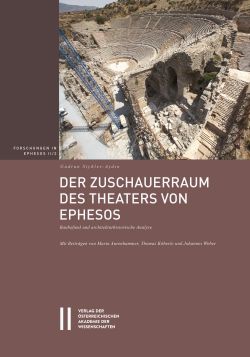


Nach der Vorstellung des archäologischen Befundes werden im zweiten Band zum Großen Theater von Ephesos nun die Ergebnisse der jüngsten Bauforschungen im Zuschauerraum des Theaters vorgestellt, die in den Jahren 2003–2011 erfolgten. Nach der einleitenden Darstellung der Forschungsgeschichte und des aktuellen Erhaltungszustands wird detailliert auf die Bauphasen des Zuschauerraumes vom Hellenismus bis in die byzantinische Zeit eingegangen und der Baubefund anhand von Zeichnungen, Kartierungen und Fotos erläutert sowie anhand von Vergleichsbauten diskutiert. Beiträge zur Skulpturenausstattung und Untersuchungen der bauzeitlichen Mörtel ergänzen den Befund. Schon in hellenistischer Zeit zählte das ephesische Theater zu den großen Theaterbauten Kleinasiens. In weiteren Ausbaustufen ab dem 1. Jahrhundert n. Chr. bis in die erste Hälfte des 2. Jahrhunderts n. Chr. entstand einer der größten kleinasiatischen Theaterräume der römischen Kaiserzeit mit einem Durchmesser von annähernd 150 Metern. Der aktuelle Baubefund ermöglicht es erstmals, den Ausbau des Theaters in Ergänzung zu dem bisher auf Inschriften basierenden Datierungsgerüst nachvollziehbar zu veranschaulichen. Auch für die Spätzeit wird der bisherige Forschungsstand durch die jüngste Bauforschung erweitert und schließt an bereits bekanntes Wissen zum Bühnengebäude an.
Gedruckt mit Unterstützung des Fonds zur Förderung der wissenschaftlichen Forschung (FWF).

…
Following on from the publication of the archaeological findings, in this second volume on the Great Theatre at Ephesos the results of the latest architectural research in the auditorium of the theatre are presented. The current work is the most recent architectural research in the auditorium of the Theatre of Ephesos which was conducted in the years 2003–2011. After an introductory description of the research history and the current state of preservation, the various building phases of the auditorium from Hellenism through to the Byzantine era are presented in detail and the architectural findings discussed using drawings, plans and photographs as well as through comparison with similar buildings. Contributions on the sculptures and investigations into the mortar used in its construction complement the findings. Even during the Hellenistic era, the Theatre at Ephesos was one of the largest theatre buildings in Asia Minor. In further stages of construction from the 1st century AD through to the first half of the 2nd century AD it became one of the biggest theatre spaces in Asia Minor of the Roman Imperial age, with a diameter of close to 150 meters. Supplementing the existing datings derived from inscriptions, the latest findings enable a comprehensive presentation of the construction of the theatre. The most recent research also expands upon the existing research on the Late period and adds to the already acquired knowledge on the stage building.
2022,
978-3-7001-8268-9
978-3-7001-8715-8
640 Seiten, davon 400 Seiten mit Farb- und s/w-Tafeln, zahlr. Farb- und s/w-Abbildungen, 1 Planmappe mit 52 Plänen
29,7x21 cm, gebunden, Deutsch, Türkisch